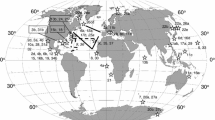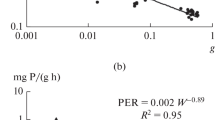Summary
An energy budget was constructed for the marine nematode Monhystera disjuncta. Respiration was measured with a modified Cartesian diver technique, in which the nematodes were kept in agar inside the diver ‘head’. The relationship between respiration and body weight was: R =1.53 W0.75. Body growth was exponential during the juvenile phase, with a growth rate equal to 0.61 d-1. After maturation the growth rate fell to 0.17 d-1. Food uptake was measured in experiments with radiolabeled bacteria. In one series of experiments the accumulation of radiolabel in the nematodes was followed. In a second series the decrease in labeling was followed when pre-labeled nematodes fed on unlabeled bacteria. A model for label uptake permitted the calculation of assimilation efficiency and consumption rates. Consumption rates thus measured, correspond well to those calculated from the growth, reproduction and respiration rates. Assimilation efficiency was low, around 25%. Production efficiency (P/(P+R)) was high: 60% for the population at stable age distribution, and up to 75% for reproducing females. This seems to be a general feature in nematodes.
Similar content being viewed by others
References
Abrams BI, Mitchell MJ (1980) Role of nematode-bacterial interactions in heterotrophic systems with emphasis on sewage sludge decomposition. Oikos 35:404–410
Admiraal W, Bouman LA, Hockstra L, Romeyn K (1983) Qualitative and quantitative interactions between microphytobenthos and herbivorous meiofauna on a brackish intertidal mudflat. Int Rev Gesamten Hydrobiol 68:175–191
Albertson DG, Thompson JN (1975) The pharynx of Caenorhabditis elegans. Philos Trans R Soc London Ser B 275:299–325
Alongi DM (1985) Effect of physical disturbance on population dynamics and trophic interactions among microbes and meiofauna. J Mar Res 43:351–364
Andrassy I (1956) The determination of volume and weight of nematodes. Acta Zool Acad Sci Hung 2:1–15
Duncan A, Schiemer F, Klekowski RZ (1974) A preliminary study of feeding rates on bacterial food by adult females of a benthic nematode, Plectus palustris De Man 1880. Pol Arch Hydrobiol 21:237–255
Findlay SEG, Tenore KR (1982) Effect of a free-living marine nematode (Diplolaimalla chitwoodi) on detrital carbon mineralization. Mar Ecol 8:161–166
Herman PMJ, Vranken G, Heip C (1984) Problems in meiofauna energy flow studies. Hydrobiologia 118:21–28
Klekowski RZ (1971) Cartesian diver microrespirometry of aquatic animals. Pol Arch Hydrobiol 18:93–114
Marchant R, Nicholas WL (1974) An energy budget for the freeliving nematode Pelodera (Rhabditidae). Oecologia (Berlin) 16:237–252
Montagna PA (1984) In situ measurement of meiobenthic grazing rates on sediment bacteria and edaphic diatoms. Mar Ecol 18:119–130
Nicholas WL, Grassia A, Viswanathan S (1973) The efficiency with which Caenorhabditis briggsae (Rhabditinae) feeds on the bacterium. Escherichia coli. Nematologica 19:411–420
Schiemer F (1982a) Food dependence and energetics of free-living nematodes. I. Respiration, growth and reproduction of Caenorhabditis briggsae at different levels of food supply. Oecologia (Berlin) 54:108–121
Schiemer F (1982b) Food dependence and energetics of freeliving nematodes. II. Life history parameters of Caenorhabditis briggsae (Nematoda) at different levels of food supply. Oecologia (Berlin) 54:122–128
Schiemer F (1983) Food dependence and energetics of freeliving nematodes. III. Comparative aspects with special consideration of two bacterivorous species Caenorhabditis briggsae and Plectus palustris. Oikos 41:32–43
Snedecor GW, Cochran WG (1967) Statistical Methods 6th ed. Iowa State University Press, Ames, Iowa. p 593
Tietjen JH (1980) Microbiol-meiofaunal interrelationships: a review. In: Microbiology 1980: VIII. Conf. Amer. Soc. Microbiol. on Ecology, Feb. 7–10, 1979, Clearwater Beach, Florida. Amer. Soc. Microbiol., Washington, D.C., USA, pp 335–338
Vranken G, Heip C (1986) The productivity of marine nematodes. Ophelia 26:429–442
Vranken G, Herman PMJ, Vincx M, Heip C (1986) A reevaluation of marine nematode productivity. Hydrobiologia 135:193–196
Vranken G, Herman PMJ, Heip C (1988) Studies of the life-history and energetics of marine and brackish-water nematodes. I. Demography of Monhystera disjuncta at different temperature and feeding conditions. Oecologia 77:296–301
Warwick RM (1981) The influence of temperature and salinity on energy partitioning in the marine nematode Diplolaimelloides bruciei. Oecologia (Berlin) 51:318–325
Warwick RM, Price R (1979) Ecological and metabolic studies on free-living nematodes from an estuarine mudflat. Estuar Coastal Mar Sci 9:257–271
Woombs M, Laybourn-Parry J (1984) Feeding biology of Diplogasteritus nudicapitatus and Rhabditis curvicaudata (Nematoda) related to food concentration and temperature, in sewage treatment plants. Oecologia (Berlin) 64:163–167
Woombs M, Laybourn-Parry J (1985) Energy partitioning in three species of nematode from polysaprobic environments. Oecologia (Berlin) 65:289–295
Author information
Authors and Affiliations
Rights and permissions
About this article
Cite this article
Herman, P.M.J., Vranken, G. Studies of the life-history and energetics of marine and brackish-water nematodes. Oecologia 77, 457–463 (1988). https://doi.org/10.1007/BF00377260
Received:
Issue Date:
DOI: https://doi.org/10.1007/BF00377260




